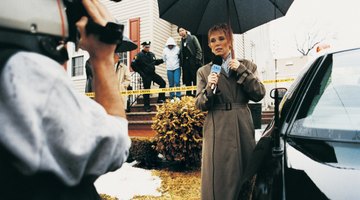According to the online reference Law Library, public perceptions on crime “are directly related to the way that media outlets portray certain events.” These perceptions can, for example, lead the public to be fearful of a certain area of a city because they have seen television highlights of a particularly heinous crime in that area. However, the media also interjects positive influences. In all instances, since media companies are businesses, they provide information in which the public is interested.
Statistics and Reporting

While statistics can lead to an overreaction or fear of crime, they can similarly have positive and practical manifestations. For example, if you live in an area that offers statistically insignificant crime incidences, you can receive discounts on homeowners and automobile insurance. Such an area also can attract new business or provide an assurance of safety so there are more people patronizing public places. Just as fears of high crime can have a negative impact, a perception of low crime also can lead to a self-fulfilling prophecy: an increased public presence can deter criminals.
Safety and Witness Tips

Some police departments, such as those in Tulsa, Oklahoma, incorporate safety or practical tips with their periodic crime reports. For example, in mentioning a rape crime, they may offer that few rapes are “stranger rapes,” committed instead by a family member or acquaintance. Media will, in turn, often repeat this information, and good journalists and editors take it one step further and offer a series of tips to help educate the public, create awareness and help their audiences implement good practices. The media also offers a venue for people to call in tips, or information, about a crime anonymously.
Garnering Publicity for Community Action and Events
National Night Out has become a national event exercised in communities across the country to demonstrate commitment and solidarity in crime prevention. The media’s announcements and coverage of this event, or movement, has played and continues to play a large part in its popularity. It has also motivated communities to start similar movements in individual neighborhoods, such as organizing community policing or enacting a neighborhood or block watch program.
Legal and Judicial Pressure
Media coverage can influence law enforcement and the judicial process in both positive and negative ways. A chain reaction can occur with the onset of media coverage, resulting in public pressure with demonstrations or other public displays, that can free a wrongfully accused or convicted person, commute a sentence or even mobilize a pro bono legal team for someone unable to afford adequate representation. In general, the public should be encouraged to have a voice in their community, while police and judicial officials should balance that attention with the interests of justice.
Related Articles
References
Resources
Writer Bio
Based in Central Texas, Karen S. Johnson is a marketing professional with more than 30 years' experience and specializes in business and equestrian topics. Her articles have appeared in several trade and business publications such as the Houston Chronicle. Johnson also co-authored a series of communications publications for the U.S. Agency for International Development. She holds a Bachelor of Science in speech from UT-Austin.











